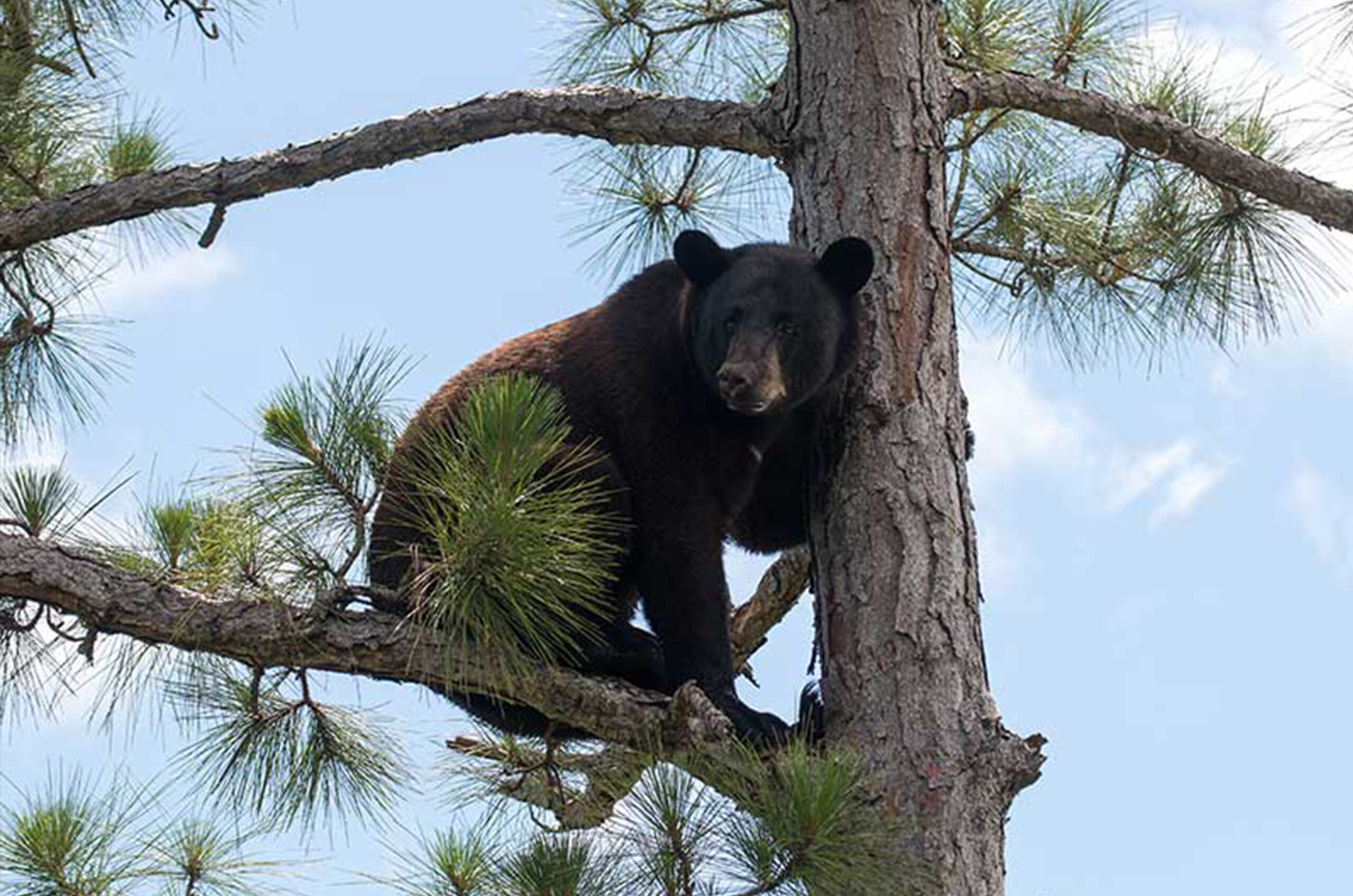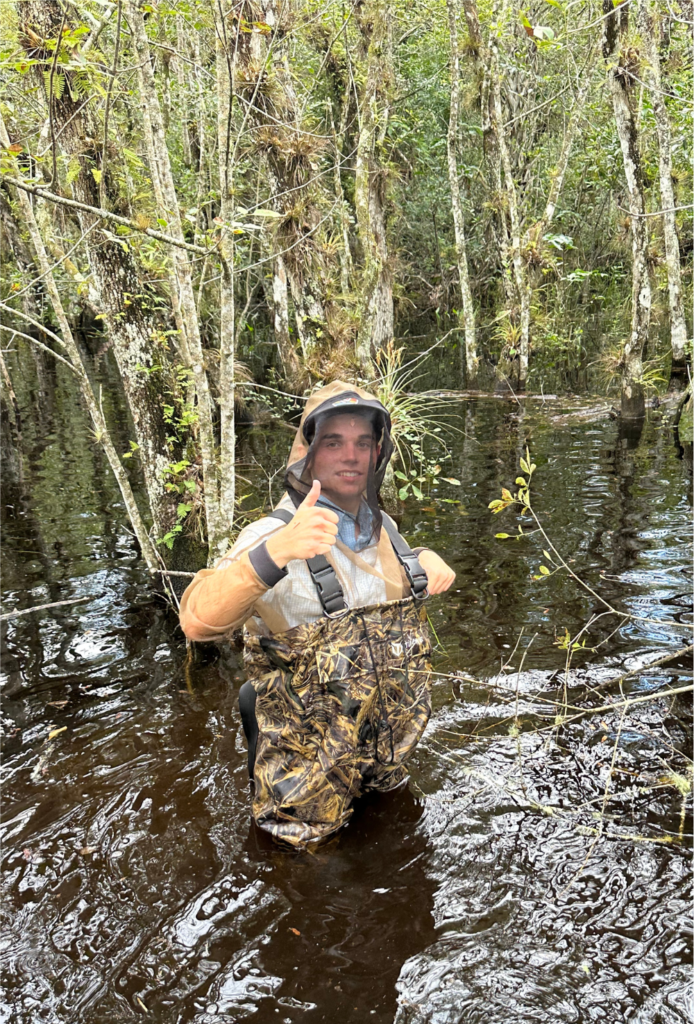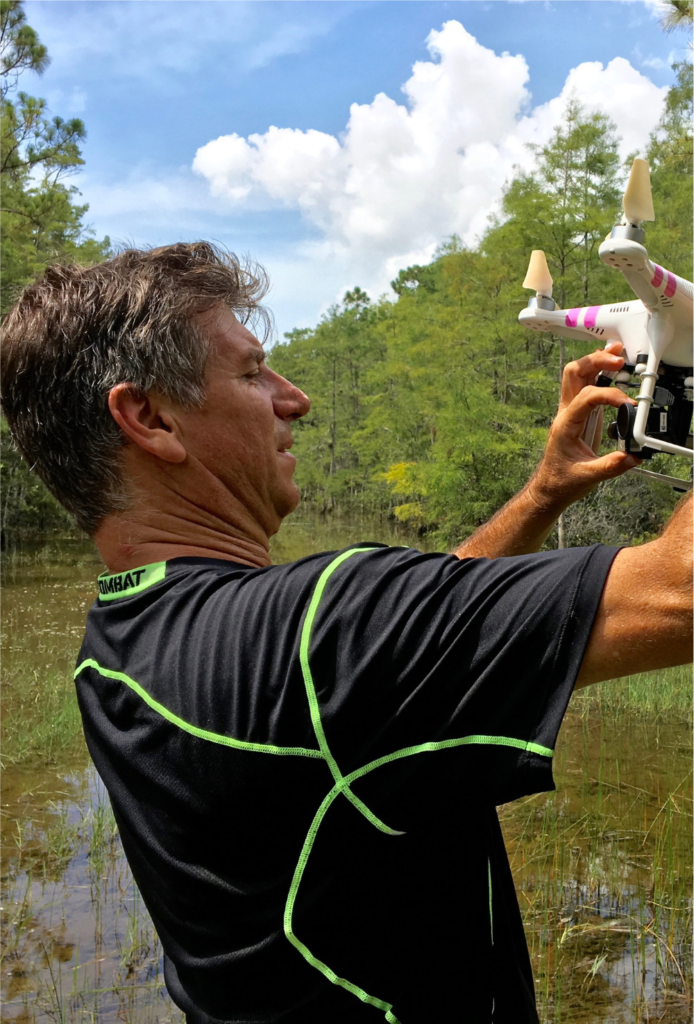Species: Florida Black Bear
(Ursus americanus floridanus)
Status: Native
Black bears are the only species of bear found in Florida, they are considered an “umbrella” species – a wide ranging species whose protection (and habitat’s protection) in turn protects numerous other species.
Geographic Range & Habitat:
The American black bear can be found throughout North America, although this particular subspecies, Ursus americanus floridanus, has skeletal and genetic differences unique to the populations in Florida. Florida black bears are found throughout the state, including the wetland habitats of the Everglades.
Within the Everglades, Florida black bears are predominately found in the western region near Big Cypress National Preserve, however there are several accounts of them in Water Conservation Area 3 and Everglades National Park. They inhabit a range of ecosystems in the Everglades, from upland pine habitat to mixed/cypress swamp as well as mangrove swamps.
Appearance:
Florida black bears are large mammals with rounded ears and short tails. Florida black bears are entirely black, although some individuals may have white markings on the chest.
Adult black bears are around 4-7 feet long, male Florida black bears can weigh up to 350 lbs. whereas females may weigh up to 180 lbs.
Diet:
Florida black bears are omnivores, but proportionally consume mostly plants (80%) and insects (15%) and only a small amount of other animals (5%). The “other animals” category includes carrion (dead animals) and animals that often play dead (e.g. Nine-banded armadillo), and some larger mammals such as White-tailed deer and feral hogs. Some favored plant species include saw palmetto, sabal palmetto, pickerelweed, sawgrass, and arrowroot.
Behavior:
Florida black bears are diurnal species, meaning they are most active during the day, although human activity can cause a switch to more nocturnal (nighttime) activity. Bears are typically solitary, but may be found together in areas with high food density. They have long claws and are excellent climbers.
American black bears, including the Florida black bear, do not undergo true hibernation; they instead experience a period of low activity referred to as “denning.” Female Florida black bears with cubs will often den for the entire winter, whereas males and females without cubs may den for a short time or not at all. In any case, Florida black bears do not rest as soundly as individuals in the northern states, and will readily run from the den if disturbed. Florida black bears have variable and potentially broad home ranges; Female home ranges are between 4-77 mi2 and for males from 48-250 mi2. Home ranges often become more restricted in the winter time during denning, most notably for females.
Reproduction:
Both male and female Florida black bears reach reproductive maturity at around 3-4 years old. Breeding season is in the late summer months (Jun.-Aug.) however females undergo “delayed implantation” where the gestation period doesn’t begin until Nov.-Dec. and lasts approximately 8-12 weeks. Litter size ranges from 1-5 cubs, and cubs will accompany their mother for around 1.5-2 years. Female cubs will often settle in home ranges overlapping their mother, whereas male cubs are forced to disperse further.
Geographic Range & Habitat:
The American black bear can be found throughout North America, although this particular subspecies, Ursus americanus floridanus, has skeletal and genetic differences unique to the populations in Florida. Florida black bears are found throughout the state, including the wetland habitats of the Everglades.
Within the Everglades, Florida black bears are predominately found in the western region near Big Cypress National Preserve, however there are several accounts of them in Water Conservation Area 3 and Everglades National Park. They inhabit a range of ecosystems in the Everglades, from upland pine habitat to mixed/cypress swamp as well as mangrove swamps.
Active research:
Recent:
- (2021) Effects of seas level rise on Florida black bears https://www.sciencedirect.com/science/article/pii/S1617138121000996
Ongoing:
- The Florida Fish and Wildlife Conservation Commission estimates abundance of Florida black bear subpopulations throughout the state every 10 years to monitor population size.
Black Bear Facts:
Did you know?
- In the 1970s, the Florida black bear population was only around 300 individuals, however conservation efforts assisted in de-listing the species in 2012. Today the population is over 4,000 individuals and growing!
- Although there are few accounts of harmful human-bear interactions, Florida black bears are often attracted to the aroma of garbage and pet food in urban areas. It is extremely important to minimize contact and secure attractants to reduce the chances of a negative interaction. Here are some tips for living with bears: https://myfwc.com/wildlifehabitats/wildlife/bear/living/attractants/
- Florida black bears are fast; they can run up to 35 mph! If you encounter one, don’t run. Answers to commonly asked questions when encountering a black bear can be found here: https://myfwc.com/wildlifehabitats/wildlife/bear/living/faqs/
References
Maehr, D. S. (1996). The comparative ecology of bobcat, black bear, and Florida panther in south Florida. University of Florida.
Informational Links
Florida Fish and Wildlife Commission (FWC)
https://myfwc.com/wildlifehabitats/wildlife/bear/facts/biology/
U.S. Fish and Wildlife Service (USFWS)
https://www.fws.gov/southeast/news/2017/04/florida-black-bear-population-continues-to-increase/
Taxonomy
- Kingdom– Animalia
- Phylum – Chordata
- Class – Mammalia
- Order– Carnivora
- Family – Ursidae
- Genus – Ursus
- Species – Ursus americanus
- Subspecies – floridanus
Species Status:
- Native
- Imperiled
Listing Status
- Federal Status –Not Listed
- FL Status – Not Listed












